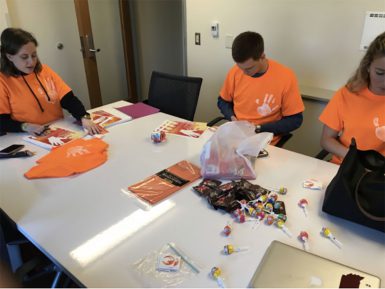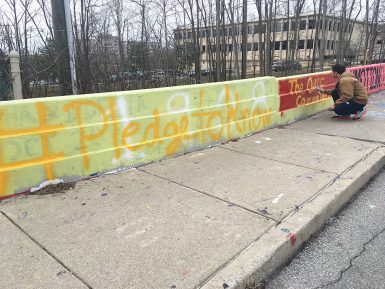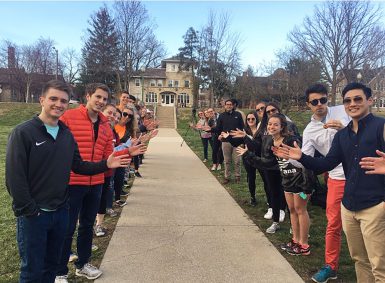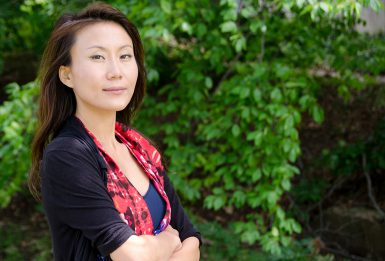Two IU teams submit campaigns to Bateman competition

Two teams of students just finished weeks-long campaigns and now are waiting to see if their efforts to change the stigma of mental health issues will result in national honors.
Students in the Beth Wood Chapter of the Public Relations Student Society of America at IU are participating in the organization’s national Bateman Case Study competition, which invites teams at chapters around the world to devise and execute campaigns on the same topic. This year, they were tasked with creating campaigns for the “Campaign to Change Direction,” which works to raise awareness of mental health.
IU PRSSA students formed two five-person teams, Cream Team and Crimson Team, to work independently on campaigns. They started developing their plans in November, put their plans into action with several events in March will submit their campaign books that document their work to the national Bateman committee April 7.
The students say they have not only had a real-world public relations campaign experience, but they’ve also learned a lot about the topic.
“Something we are trying to get across is that mental illness and mental health are different things,” said senior Bailey Briscoe, Cream Team leader. “Everyone experiences mental health. It fluctuates just like your physical health. We need to be more open and talk about it as we do with our physical health.”

The Cream Team focused on IU freshman after research showed that freshman tend to have higher stress levels on campus than other students.
“Freshman are our targeted audience because they are adjusting to a new environment, and this is a time when they are making really big adjustments in their lives,” Briscoe said. “They are going through different changes, and that’s the core audience that experiences the most mental health issues, whether stress or depression.”
They hosted events across campus, focusing on areas where freshman are likely to be hanging out, and educating people on the five signs of mental suffering: personality change, agitation, withdrawal, poor self-care and hopelessness. They passed out brochures and stickers and painted bridges and sidewalks on campus.
Participating students signed pledges after they were taught the five signs. The team devised handouts that explained the signs and offered resources for people to get help if they noticed a friend was exhibiting this behavior or if they were struggling themselves. The team’s goal for early March was to get 50-100 signatures on their pledges.
Briscoe said in addition to providing a service, the team had the experience of what it would be like to work with clients.
“This was similar to what it would be like in an agency setting,” she said. “Clients give you ideas of what they wanted the campaign to be about and who their target audience is.. Then, you research your local community to figure out where the campaign is most needed. So we are really doing a ground up, ground roots campaign.”

Students on the Crimson Team had the same time frame and the same campaign client, but went a different direction with their implementation, “Gimme 5.” It focused on the five signs of mental health. The Crimson Team decided to try to break the world-record for the most high-fives in 30 seconds with an event in Dunn Meadow in early March. Participants who learned the five signs gave one another high fives.
“High-fives make it an easy way to remember the signs,” said senior Courtney Pories, Crimson Team leader. “It’s a way to positively interact with each other and it’s enthusiastic.”
The team did record 154 high fives in 30 seconds, which they submitted to the Guinness Book of World Records.
The Crimson Team focused their campaign on IU students as a whole and tried to get as many student groups involved as possible.
“We realized during our research that there has been some negative experiences with the resources on campus, or people don’t know about all of their options. It is such an issue that students don’t know the difference between mental health and mental illness,” Pories said. “Everyone experiences good and bad mental health, and how you handle and talk about it is important. We wanted to educate students and give them places to get help.”
To get student groups involved, the team created a competition between the different groups on campus. The Crimson Team created a page online, where the student groups made pledges to be aware of the five-signs of mental suffering and to help each other out when they notice them.
When the groups made these pledges online, the Crimson Team announced that on its Facebook page. Teams who got the most likes/shares on the Facebook post won a pizza party.

Assistant professor Minjeong Kang, the PRSSA faculty advisor, mentors PRSSA students, especially during the Bateman Competition, though the organization and the competition are both run almost exclusively by the students themselves. In her six years as advisor, Kang has worked with several IU Bateman teams, several of which have earned honorable mentions, which means they were in the top 10 entries of more than 300.
Once they submit their campaign documentation, teams will wait for judging. The Bateman committee will assess each campaign book and give it a score out of 100 based on theme, implementation, how many people they reached and other aspects of a successful campaign. Then the top three three teams will present their campaigns in New York and the winning team presents its campaign at the national PRSSA conference.
“Being a part of the Bateman competition itself is an honor,” Kang said, who added that students who compete often do well in their first jobs because they’ve had this experience.
PRSSA will announce the 2017 winners in May.

